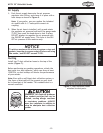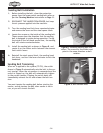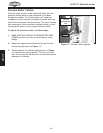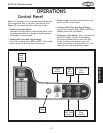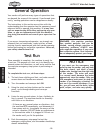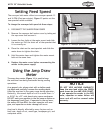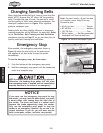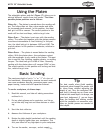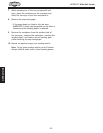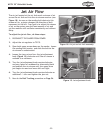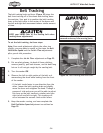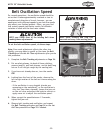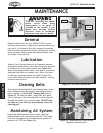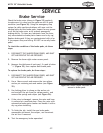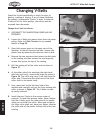
-21-
W1751 25" Wide-Belt Sander
OPERATIONS
Using the Platen
Figure 17. Platen control.
The maximum depth of cut is
1
⁄64" or
1
⁄8
th
of a turn of
the handwheel. Attempting to remove too much material
can cause workpiece burning, premature paper wear,
paper tearing, motor stall and capacitor burnout.
To sand a workpiece, do these steps:
1. Read this manual, and take all safety precautions
outlined in it.
2. Put on safety glasses and a respirator, and tie up
out of-the-way long hair and loose sleeves or cloth
-
ing.
3. Start the dust collector.
4. Measure the thickness of your workpiece.
5. Rotate the table height handwheel until the sanding
depth is slightly higher than your workpiece. This
first pass takes off any high spots in your workpiece.
6. Turn on the sander, conveyor, and air supply.
Basic Sanding
For best results when finish sanding,
feed each piece through the sander two
or three times without adjusting the
depth of cut. Turn the workpiece 180˚
and feed it through two or three more
times at this same depth. As always, use
your best judgement. If you no longer
hear the sanding belt making contact
with the workpiece on successive cuts,
then no further passes are needed at
that depth.
Tip
The adjustable platen and dial (Figure 17) allows you to
achieve different results from your sander. The three
possible platen positions are as follows:
Platen Up — The platen is moved above the sanding roll
-
ers. The rollers then act like a drum sander and allow
for increased stock removal. In this position, the ideal
belt grit is #100 or coarser. The scratch pattern in this
mode will be short and deep, relative to grit size.
Platen Even — The platen is set even with the sanding
rollers. The rollers act together with the platen pressure
to achieve intermediate or final finishing. In this posi
-
tion, the ideal belt grit is between #100 and #180. The
scratch pattern in this position is moderate, relative to
grit size.
Platen Down — The platen is moved below the sanding
rollers. With the platen down, the workpiece contact
with the sandpaper is only made at the platen. This posi
-
tion is used for fine finishing, sanding repairs, or sanding
lacquer. The ideal belt grit is #180 or finer. Generally
sanding with the platen down will remove 0.004" or less.
The scratch pattern in this position will be long and shal
-
low, relative to grit size.



